|
Tags: culture | development
|
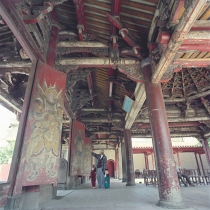
The Lungshan Temple in the town of Lukang is ranked as a first-class historical site. This treasure of Taiwanese architecture has impressive artistry, colorful decorations, and pillars with delicately carved dragons.
Photo by: GIO Photographer
|
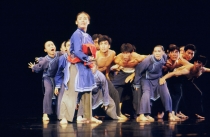
The internationally acclaimed Cloud Gate Dance Theatre is the first professional modern dance troupe in Taiwan. The dance “Legacy” tells the story of hardship experienced by Taiwan’s early settlers.
Photo by: GIO Photographer
|

Dragon boat races, now an important activity of the Dragon Boat Festival, are a legacy of the ancient practice of making offerings on rivers in memory of the poet and martyr, Chu Yuan (343-290 B.C.).
Photo by: GIO Photographer
|
|
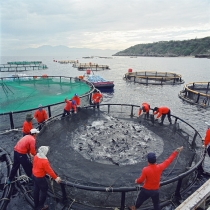
The development of offshore aquaculture is part of Taiwan's efforts to enter the world's fishery market. This offshore aquaculture farm managed by the Pan Asia Ocean Company in Liu Chiu, Pingtung County, is raising Cobia fish (Rachycentron cancadum).
Photo by: GIO Photographer
|
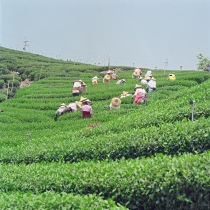
Because of suitable climate and environment, Taiwan is an important tea producer, and tea is one of it’s major economic crops. Tender leaves are picked by hand to ensure quality.
Photo by: GIO Photographer
|
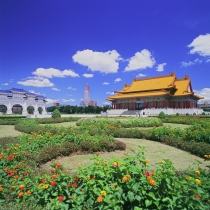
Two traditional Chinese buildings, the archway of the Chiang Kai-shek Memorial Hall and the National Concert Hall, form an interesting contrast to the modern skyscrapers rising in the distance.
Photo by: GIO Photographer
|
I. Witnessing Taiwan's Development—Social Evolution
Taiwan has emerged as one of the world's leading producers of high-tech products, including computer monitors, motherboards, keyboards, and other components. Politically, the Republic of China's 23 million people have just experienced a peaceful and unprecedented change of governing party. Taiwan's democratic achievements have been strongly affirmed by the world community.
This is the Taiwan known throughout the world.
Looking back at history, one asks how Taiwan has become what it is today. Over the years, Taiwan has undergone tremendous economic development that has brought about social transformation. Since the government first proceeded with a land reform program in the 1950s, the Ten Major Construction Projects of the 1970s, and a series of enlightened economic plans over the years, Taiwan's economy has been transformed from one based on agriculture to one based on information industries. The per capita income of Taiwan has increased from less than US$140 in the 1940s to today's US$13,000. This economic miracle is an accomplishment, thanks to the concerted efforts of the government and diligent, well-educated citizens. Taiwan's success has won worldwide recognition as a model for many developing nations.
This collection of color and black-and-white photos illustrates a striking contrast between the island's present prosperity and its earlier poverty. The images in this collection reflect the vibrant and varied lifestyles that make up Taiwan's rags-to-riches stories over the past half-century.
II. Cherishing the Earth's Assets—Natural Scenery
Lofty Mountains, deep valleys, rushing rivers, and scattered islets with a mountain range rising to elevations of four thousand meters compose the beautiful island of Taiwan or "Formosa." The island is the result of a collision of the Euro-Asia and Philippine plates, erosion, and exposure to weather.
Taiwan, with its subtropical climate, has varied and unique scenery. For example, the much visited Taroko Gorge in Hualien County, was formed by erosion of the Liwu River cutting through marble. Towering Mount Jade and Mount Tapachien have attracted professional as well as amateur climbers. Sandy beaches, rocky seashore and small offshore islands offer year-round getaway spots. Abundant forests and trees provide a green canopy to much of the island's mountainous terrain.
However, economic activities have drastically altered the scenery and natural environment, and affected the habitats of animals and plants. Taiwan has thus adopted a strategy of sustainable development with an emphasis on environmental protection aiming at creating a "green miracle" for the future of all human beings and the earth.
III. Protecting Biodiversity—Wildlife Conservation
Taiwan has a warm climate, abundant rainfall, and a varied topography. All these advantages have contributed to the rich diversity of fauna and flora found in Taiwan. Surrounded by the sea, the island of Taiwan has fertile mud beaches and plentiful mangroves along the coast, providing homes to birds and other species living by the sea. Indeed, Taiwan has a very diverse ecological system. It is also home to a large number of bird species, as many migratory birds winter in Taiwan.
Natural resources are very fragile, and it is difficult to restore them once they are destroyed. Some damage is even permanent. Ecological destruction can lead to a broken food chain, a decrease in the number of species, or even extinction.
Under the joint efforts of the government and the private sector in the Republic of China in recent years, Taiwan revised its wildlife conservation-related laws and regulations to reinforce conservation education and prohibit sales of wildlife and their products. The whole country is working together to promote wildlife protection.
In addition to conservation efforts at home, Taiwan has joined with other nations to assist the international community in carrying out the work of wildlife conservation. For example, Taiwan has donated two aircraft to help nations in Africa crack down on illegal hunting, assisted Senegal in breeding scimitar oryx, conducted investigations on illegal hunting in Mole National Park in Ghana, and donated money to the enforcement committee of the Lusaka Agreement. All these actions testify to the ROC's support for wildlife conservation in the international community.
Wildlife conservation has no borders. We hope the international community can assist Taiwan in gaining admission to international wildlife conservation organizations, thus allowing Taiwan to make concerted efforts with other countries in protecting the diversity of life around the globe.
IV. Cultural Heritage—Customs and Festivals
Festivals are the mirror of a culture and can provide a better understanding of a nation and its people. In the minds of many people around the world, Chinese people are represented by their most important folk festival—the Lunar New Year. Likewise, people in East Asia associate Christmas celebrations with Western societies.
The origin of Chinese folk festivals can be traced to agricultural society, when seasonal changes determined the timing of rural activities like spring plowing, summer weeding, autumn harvest, and winter storage. As mythical stories evolved and religious rituals were performed in association with these farming activities, recreational, joyful, and memorial folk celebrations developed for the different seasons of the year. Different forms of drama, song, and folk art began to play an important role in these celebrations.
Folk festivals reflect a people's faith and concepts about life and the universe. Related celebrations take man into the spiritual world of his forefathers. Today, many art creations are a blend of new ideas with those derived from folk festivals.
In addition to national folk festivals, local activities have evolved in urban and rural townships as well. For instance, the beehive fireworks celebration in Yenshui, Tainan County; the pole-climbing competition in Toucheng, Ilan County; and the Ghost Festival celebrations in Keelung City are closely interwoven with the lives of the local communities.
In recent years, the ROC government has vigorously promoted a number of activities in association with folk festivals, such as the Taipei Lantern Festival and the Children's Folklore and Folkgame Festival, as part of an effort to enhance folk celebrations and transform them into important international folk activities.
V. Embracing Diversity—Culture and the Arts
Culture is diverse and all encompassing. It can include such everyday aspects as clothing, food, shelter, and transportation, or artistic aspects such as drama, the fine arts, music, and dance. It is the sum total of the human experience.
From the early days of Han Chinese settlement, to the relocation of the Nationalist's central government in 1949, and the more recent influx of Western cultural influence, Taiwan has undergone great cultural change and adopted the cultures of different ethnic groups. Today, Peking Opera, Taiwanese glove puppetry, modern Western dance, Chinese shadow puppet shows, and different types of drama co-exist in Taiwan.
After several decades of rapid economic and social development, people in Taiwan have begun to pay closer attention to their cultural roots. More time and energy are being spent to raise cultural standards. Counties and cities have established cultural bureaus to promote culture and art activities, and cultural, literary and art awards have been created, including the prestigious title of Folk Art Master. These efforts have generated strong public interest in cultural and art activities. During celebrations, cultural and art performances have become the focus of activities.
Many groups and artists have been invited to other countries for performances or exhibitions, bringing greater international recognition to Taiwan's culture. The ROC government has also established cultural centers in other countries to introduce Chinese culture and raise Taiwan's cultural image.
Today, art and culture are an important part of everybody's life in Taiwan, and people have broadened their vision of Chinese culture and embraced diversity.
VI. Equality for All—Concern for Human Rights
Life and equality regardless of race, gender, or age are principles valued throughout the world. In recent years, Taiwan's standards of human rights, democracy, and basic freedoms have made great strides, from resistance to oppression in the early years, to mutual respect and compromise among people today.
In addition to the establishment of the February 28 Peace Park in Taipei and the Human Rights Memorial on Green Island, human rights for children, women, and aborigines have been greatly promoted.
For example, the Chinese Association for Human Rights established the first tribal care station for the Yungan tribe in a remote part of Miaoli County to provide learning opportunities for elementary school students and skills and employment for teenagers. Such a project advances the human rights of aborigine peoples.
Internationally, the government and the private sector have joined to help developing countries build hospitals to protect the health rights of local people, and provide relief assistance to earthquake-stricken areas in the Chinese mainland, El Salvador, and India. International relief funds have been established, which have aided more than 40 nations and provided more than US$100 million in relief and humanitarian assistance.
Taiwan is working to protect individual dignity and ensure basic human rights to build a society based on democracy and law in accordance with world human rights standards.
Taiwan Image - Photo Archive
Text and images are provided by Ministry of Foreign Affairs, Republic of China (TAIWAN)
|